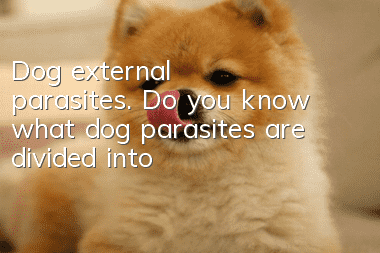Dog external parasites. Do you know what dog parasites are divided into?

Dog external parasites are fleas
Dog fleas are different from the fleas that attack humans and cats. Fleas can serve as intermediate hosts for other parasites, but the main problem is that they can irritate the skin. Symptoms: The bite site looks like small red papules; there is a black gritty substance in the fur. In some more sensitive dogs, flea saliva can cause extensive inflammation on the dog's back. Apply flea spray regularly to infested areas to keep the area clean.Dog external parasites are lice
There are eating lice (chewing the thin layer of skin) and sucking lice (because it will penetrate the skin and use tissue fluid as food, causing irritation larger). Neither family of lice is spread to humans or cats. Lice are gray in color and stick to the dog's fur. Repeat insecticide sprays or bath treatments (at least 3 times every 5-7 days) to kill adults and any hatching larvae.The external parasite of dogs is ticks
The most common external parasite on dogs is the sheep tick. Its abdomen is large, congested and elongated; it often sticks to the dog's hair and stretches out its mouthparts. Entering the skin to suck blood; ticks are usually found on a dog's underside, under its front legs, or on its head. Efforts must be made to remove a tick whenever you see it. Pull out the head to avoid abscess formation. If the head remains in the skin, apply warm compresses combined with antiseptic lotions and creams to prevent infection. Alcohol can be applied to the tick's body to relax or kill the tick's head. After a few minutes, use sharp-tipped tweezers and pull sharply in a vertical direction to remove the tick.The external parasite of dogs is tapeworm
The most common dog tapeworm is Tapeworm canis. As larvae develop inside the body of the flea. The segments of the melon tapeworm are like wriggling rice grains, which can make the dog's anus itchy and cause the dog to walk with its tail hanging down. Current treatments can eliminate all types of tapeworms. If any proglottids are seen in the dog's feces, they should be treated as soon as possible and both the dog and the kennel should be sprayed with insecticides. Random articles
- What to do if your dog doesn’t like to drink water? You must know these six things
- How to choose a Teddy puppy? What should you pay attention to?
- Is it good to neuter your Kerry Blue Terrier? Do you know the pros and cons of neutering your Kerry Blue Terrier?
- Why is Pomeranian losing hair so much? Have you done it scientifically?
- What should Czech Terriers eat after giving birth? How to supplement nutrition for Czech Terriers after giving birth?
- Symptoms of Postpartum Calcium Deficiency in Irish Soft-Coated Terrier Caring for Postpartum Irish Soft-Coated Terrier with Postpartum Calcium Deficiency
- Dogs are shaking and vomiting. Do you know why dogs are shaking and vomiting?
- How to teach a German Shepherd to sit and stand? It’s important to master these skills
- How to care for postpartum lochia in Labrador. Treatment of postpartum lochia in Labrador.
- How to get rid of bad breath as a Teddy dog. It only takes three steps to freshen your breath.



